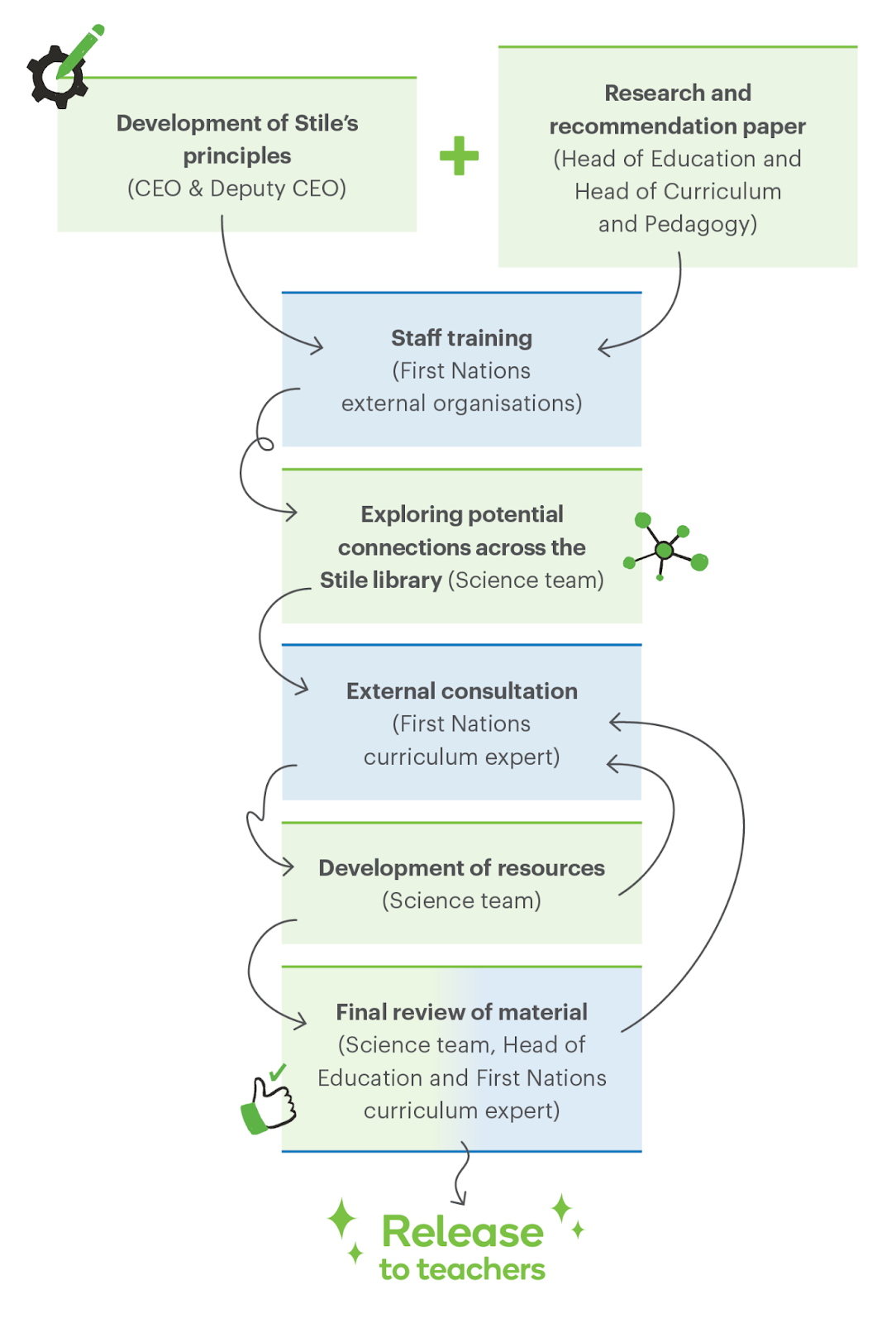Learning and teaching First Nations Histories and Cultures in Stile
Learn how Stile approaches learning and teaching First Nations Histories and Cultures in science education, supporting teachers with respectful, accurate, and culturally safe resources.

Acknowledgement of Country Stile acknowledges the Traditional Owners of Country throughout Victoria and recognises Aboriginal and Torres Strait Islander Peoples as the world’s first scientists. We pay our respects to Elders past and present, and honour the knowledge systems that continue to guide and shape our understanding of science.
Curriculum context
Embedding First Nations Histories and Cultures is not only a curriculum requirement but an opportunity to strengthen equity and enrich science learning for all students.
For Aboriginal and Torres Strait Islander students, it means seeing their cultures, knowledge, and identities reflected in the classroom. For all students, it means engaging with the world’s oldest continuous living cultures and recognising the contributions these knowledge systems continue to make to science.
National initiatives such as the Closing the Gap agreement highlight the need to improve equity and outcomes, particularly in science, technology, engineering, and mathematics (STEM). Embedding First Nations Histories and Cultures in science education is one way schools can contribute to these goals while also deepening learning for everyone.
Stile’s role is to support teachers in this responsibility by providing content that is respectful, accurate and culturally safe.
The principles we are guided by
Our approach is grounded in respect, responsibility and humility. We recognise that Aboriginal and Torres Strait Islander Peoples are diverse and that knowledge, practices and cultural protocols vary across communities. Our role is to listen, learn and support teachers in engaging with this content respectfully.
To uphold this responsibility, we:
- Act as allies, not authorities
- Actively seek advice from First Nations Peoples
- Respect and protect Indigenous Cultural and Intellectual Property (ICIP)
- Promote benefit sharing with First Nations Peoples and organisations
- Encourage educators and students to connect with local communities for deeper learning
This work takes time. Trust, permissions, and relationships cannot be rushed.
Our approach
Stile’s science team has undertaken extensive professional development, research and training, with a strong focus on protecting Indigenous Cultural and Intellectual Property (ICIP). Our work is guided by the Australian Curriculum elaborations for Aboriginal and Torres Strait Islander Histories and Cultures, and strengthened by ongoing advice from First Nations educators, curriculum experts and community representatives.
An overview of our comprehensive review process is illustrated below.

Through these efforts, we aim to contribute to a more inclusive and representative science curriculum that benefits all students while respecting and celebrating Aboriginal and Torres Strait Islander Knowledge and contributions to science.
Our commitment to cultural safety
All content that explores First Nations Histories and Cultures in Stile goes through a rigorous review process that includes consultation with external advisors and curriculum experts. This material is also reviewed regularly to ensure it remains accurate and culturally safe.
Stile Guarantee: Where First Nations Histories and Cultures have been included in our collection, resources have been developed and reviewed through the above process. Where cultural safety cannot be assured, we defer inclusion until the appropriate advice, permissions, and relationships are in place.
How First Nations Histories and Cultures are woven into Stile
This material is carefully embedded throughout Stile in three main ways:
Unit-level explorations
Units in which Aboriginal and Torres Strait Islander Histories and Cultures act as the unit’s driving phenomena.
- For example, features Professor Chris Lawrence, founder of NISA (the National Indigenous Space Academy), as the career profile. Students explore how First Nations' Knowledge has contributed to our understanding of forces, from spear throwers to space travel.
Lesson hooks and anchoring phenomena
Lessons that begin with a First Nations context to spark inquiry and ground the learning in real-world examples.
- For example, the Extracting and Using Resources lesson in the Periodic Table explores Wilgie Mia, the world’s oldest continuing mine.
Contextual inclusions throughout lessons
Knowledge and Histories are also woven into lesson details through Did You Knows, teacher tips, and contextual notes.
- Further examples appear across units such as Our Place in Space, Mixtures, and Immune System.
Learn more: Exploring First Nations content across the Stile Library
Guidance for your classroom
We understand that many teachers may feel uncertain about the process of incorporating First Nations content.
Our lessons include notes and guidance so teachers feel prepared to include this important content in the classroom:
- Teaching plans and notes include cultural context, curriculum links and suggested discussion points.
- Carefully curated references are provided at the end of each lesson. Some are for teacher background only and may contain outdated or harmful language; these are clearly marked and not hyperlinked. Others are safe for classroom use and are identified as such.
Guidance from community
Most importantly, Local Traditional Owners are always the most appropriate source of knowledge about your local Cultures, Histories and knowledge systems. Stile’s lessons are a starting point, not the final word.
For teachers in New South Wales and Victoria:
- New South Wales: Aboriginal Education Consultative Group (AECG)
- Victoria: Victorian Aboriginal Education Association Incorporated (VAEAI)|
Teachers in other states can connect with their local Aboriginal Education bodies or community organisations for guidance.
Continuing this work with care
Published sources and ongoing collaborations with First Nations curriculum experts have guided our content.
This work is underway in areas such as:
- Active Earth – Oral accounts of earthquakes and volcanoes, including those that formed the Budj Bim cultural landscape.
- Evolution – Aboriginal artwork indicating changes in plants and animals, including megafauna
- Waves – Traditional instruments and sound energy
Respecting protocols in curriculum design
Some curriculum standards cannot be addressed without direct community permission.
- Classification systems are closely tied to totems and moieties, and to proceed without permission would risk breaching ICIP.
In these cases, some curriculum standards will remain unmet until they can be approached in a culturally safe way.
We cannot commit to timelines, as these are set by communities, not by us. Trust, permission-seeking, and relationship-building take time. This work will be completed only when it is appropriate to do so.
Why are we sharing this with you?
This page exists to help teachers locate and understand the many examples of Aboriginal and Torres Strait Islander Histories and Cultures embedded throughout the Stile library. Its purpose is to provide support and transparency.
The knowledge belongs to communities. Our role is to support teachers in engaging with it in culturally respectful ways.
Continuing this journey
Stile aims to contribute to a more inclusive, representative and culturally safe science curriculum. We are grateful to the First Nations educators, curriculum experts, scientists and communities who guide us. Our role is to keep listening, learning, and building these partnerships over time.

